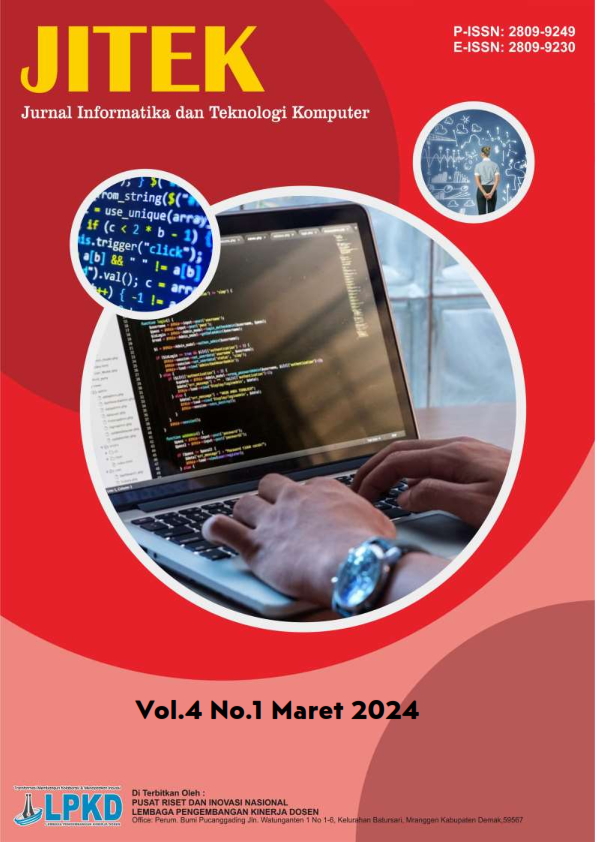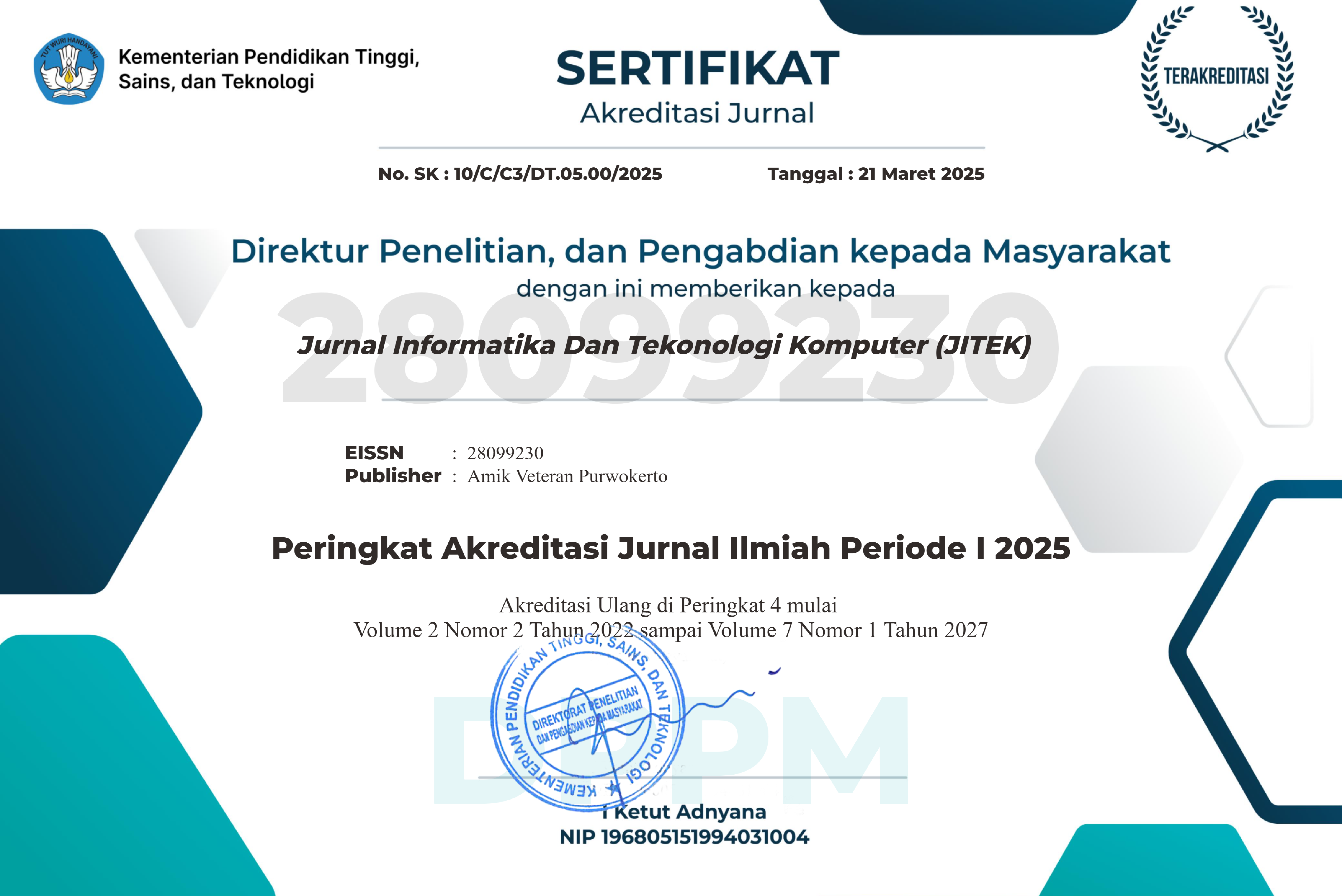Studi Kinerja Mesh Network untuk Penerapan Internet of Things (IoT) di Lingkungan Perkotaan
DOI:
https://doi.org/10.55606/jitek.v5i1.5895Keywords:
Network, IoT, Mesh, Simulation, PerformanceAbstract
The Internet of Things (IoT) has become a crucial component in the development of smart cities, enabling seamless integration and communication among various devices to enhance public service efficiency. In densely populated and complex urban environments, a reliable and flexible communication infrastructure is essential. Mesh networks offer a promising solution due to their ability to provide dynamic connectivity, wide coverage, and resilience to node failures. This study aims to evaluate the performance of mesh networks in supporting IoT implementation in urban settings through a simulation-based approach. Key performance parameters analyzed include throughput, latency, packet delivery ratio (PDR), and energy consumption. Simulations are conducted by varying the number of nodes and network topologies to reflect real-world urban conditions. The results indicate that mesh networks can deliver stable and efficient communication performance in IoT scenarios, although challenges such as increased latency and reduced energy efficiency in large-scale deployments must be addressed. These findings offer valuable insights for the design and implementation of mesh-based IoT networks in urban environments.
References
[1] F. A. Almalki et al., “Green IoT for Eco-Friendly and Sustainable Smart Cities: Future Directions and Opportunities,” Mob. Networks Appl., vol. 28, no. 1, pp. 178–202, 2023, doi: 10.1007/s11036-021-01790-w.
[2] E. C. P. Neto, S. Dadkhah, R. Ferreira, A. Zohourian, R. Lu, and A. A. Ghorbani, “CICIoT2023: A Real-Time Dataset and Benchmark for Large-Scale Attacks in IoT Environment,” Sensors, vol. 23, no. 13, 2023, doi: 10.3390/s23135941.
[3] H. C. Altunay and Z. Albayrak, “A hybrid CNN + LSTMbased intrusion detection system for industrial IoT networks,” Eng. Sci. Technol. an Int. J., vol. 38, 2023, doi: 10.1016/j.jestch.2022.101322.
[4] D. Sousa, S. Sargento, and M. Luis, “A Simulation Environment for Software Defined Wireless Networks with Legacy Devices,” Q2SWinet 2022 - Proc. 18th ACM Int. Symp. QoS Secur. Wirel. Mob. Networks, pp. 1–10, 2022, doi: 10.1145/3551661.3561369.
[5] Z. Liu, S. Zhang, X. Shao, and Z. Wu, “Accurate and efficient urban wind prediction at city-scale with memory-scalable graph neural network,” Sustain. Cities Soc., vol. 99, 2023, doi: 10.1016/j.scs.2023.104935.
[6] S. Mishra, V. K. Jain, K. Gyoda, and S. Jain, “An efficient content replacement policy to retain essential content in information-centric networking based internet of things network,” Ad Hoc Networks, vol. 155, 2024, doi: 10.1016/j.adhoc.2023.103389.
[7] S. T. Ahmed, A. A. Ahmed, A. Annamalai, and M. F. Chouikha, “A Scalable and Energy-Efficient LoRaWAN-Based Geofencing System for Remote Monitoring of Vulnerable Communities,” IEEE Access, vol. 12, pp. 48540–48554, 2024, doi: 10.1109/ACCESS.2024.3383778.
[8] J. Logeshwaran, S. K. Patel, O. P. Kumar, and F. A. Al-Zahrani, “Hybrid optimization for efficient 6G IoT traffic management and multi-routing strategy,” 2024, nature.com. doi: 10.1038/s41598-024-81709-z.
[9] R. Kumar, V. U., and V. Tiwari, “Optimized traffic engineering in Software Defined Wireless Network based IoT (SDWN-IoT): State-of-the-art, research opportunities and challenges,” Comput. Sci. Rev., vol. 49, 2023, doi: 10.1016/j.cosrev.2023.100572.
[10] P. Sharma, S. Namasudra, R. Gonzalez Crespo, J. Parra-Fuente, and M. Chandra Trivedi, “EHDHE: Enhancing security of healthcare documents in IoT-enabled digital healthcare ecosystems using blockchain,” Inf. Sci. (Ny)., vol. 629, pp. 703–718, 2023, doi: 10.1016/j.ins.2023.01.148.
[11] S. Bommu et al., “Smart City IoT System Network Level Routing Analysis and Blockchain Security Based Implementation,” 2023, Springer. doi: 10.1007/s42835-022-01239-4.
[12] K. Li et al., “When Internet of Things Meets Metaverse: Convergence of Physical and Cyber Worlds,” IEEE Internet Things J., vol. 10, no. 5, pp. 4148–4173, 2023, doi: 10.1109/JIOT.2022.3232845.
[13] M. Malnar and N. Jevtic, “An improvement of AODV protocol for the overhead reduction in scalable dynamic wireless ad hoc networks,” Wirel. Networks, vol. 28, no. 3, pp. 1039–1051, 2022, doi: 10.1007/s11276-022-02890-5.
[14] A. I. Griva et al., “LoRa-Based IoT Network Assessment in Rural and Urban Scenarios,” 2023, mdpi.com. doi: 10.3390/s23031695.
[15] T. Mazhar et al., “Analysis of Challenges and Solutions of IoT in Smart Grids Using AI and Machine Learning Techniques: A Review,” Electron., vol. 12, no. 1, 2023, doi: 10.3390/electronics12010242.
[16] R. A. Putra and A. Ma’arif, “Internet of Things (IoT) Based Speed Monitoring System for Electric Cars,” Bul. Ilm. Sarj. Tek. Elektro, vol. 6, no. 2, pp. 182–189, 2024, doi: 10.12928/biste.v6i2.11317.
[17] G. Ramkumar, J. Seetha, R. Priyadarshini, M. Gopila, and G. Saranya, “IoT-based patient monitoring system for predicting heart disease using deep learning,” Meas. J. Int. Meas. Confed., vol. 218, 2023, doi: 10.1016/j.measurement.2023.113235.
[18] X. L. Li, Z. N. Liu, T. Chen, T. J. Mu, R. R. Martin, and S. M. Hu, “Mesh Neural Networks Based on Dual Graph Pyramids,” IEEE Trans. Vis. Comput. Graph., vol. 30, no. 7, pp. 4211–4224, 2024, doi: 10.1109/TVCG.2023.3257035.
[19] P. Santhuja, C. S. Ranganathan, C. Sasi Kumar, S. Srinivasan, and N. Latha, “Route Stability with Node Reliability-Based Auto Reconfiguration in Wireless Mesh Network,” 2023 2nd Int. Conf. Smart Technol. Smart Nation, SmartTechCon 2023, pp. 1271–1275, 2023, doi: 10.1109/SmartTechCon57526.2023.10391314.
[20] A. Singh, S. Prakash, and S. Singh, “Optimization of reinforcement routing for wireless mesh network using machine learning and high-performance computing,” Concurr. Comput. Pract. Exp., vol. 34, no. 15, 2022, doi: 10.1002/cpe.6960.
[21] D. Zhou, M. Sheng, J. Li, and Z. Han, “Aerospace Integrated Networks Innovation for Empowering 6G: A Survey and Future Challenges,” IEEE Commun. Surv. Tutorials, vol. 25, no. 2, pp. 975–1019, 2023, doi: 10.1109/COMST.2023.3245614.
[22] N. Udugampola, X. Ai, B. Li, and A. Seneviratne, “Scalability Analysis of Linear LoRa Mesh Networks,” Proc. - IEEE Comput. Soc. Annu. Int. Symp. Model. Anal. Simul. Comput. Telecommun. Syst. MASCOTS, 2024, doi: 10.1109/MASCOTS64422.2024.10786574.
[23] A. Gallegos Ramonet, T. Pecorella, B. Picano, and K. Kinoshita, “Perspectives on IoT-oriented network simulation systems,” 2024, tokushima-u.repo.nii.ac.jp. doi: 10.1016/j.comnet.2024.110749.
[24] A. K. Tyagi, S. Dananjayan, D. Agarwal, and H. F. Thariq Ahmed, “Blockchain—Internet of Things Applications: Opportunities and Challenges for Industry 4.0 and Society 5.0,” Sensors, vol. 23, no. 2, 2023, doi: 10.3390/s23020947.
[25] R. Chen, Y. Liu, Q. Han, D. Chen, and L. Zeng, “An Improved QoS-Aware Partially Multipath DSR Protocol for Wireless Mesh Networks,” 2023 7th Int. Conf. Commun. Inf. Syst. ICCIS 2023, pp. 7–13, 2023, doi: 10.1109/ICCIS59958.2023.10453663.
[26] V. K. Krishnamoorthy et al., “Energy Saving Optimization Technique-Based Routing Protocol in Mobile Ad-Hoc Network with IoT Environment,” 2023, mdpi.com. doi: 10.3390/en16031385.
[27] D. A. Turlykozhayeva et al., “Evaluating Routing Algorithms Across Different Wireless Mesh Network Topologies Using Ns-3 Simulator,” 2024, researchgate.net. doi: 10.31489/2024No2/70-82.
[28] R. Hari Sing and V. B. Narsimha, “Routing Protocols and Their Performance in Mobile Ad hoc Networks: A Quality of Service Optimization Perspective,” 2022 OPJU Int. Technol. Conf. Emerg. Technol. Sustain. Dev. OTCON 2022, 2023, doi: 10.1109/OTCON56053.2023.10113987.
[29] H. Kamyab et al., “The latest innovative avenues for the utilization of artificial Intelligence and big data analytics in water resource management,” Results Eng., vol. 20, 2023, doi: 10.1016/j.rineng.2023.101566.
[30] J. P. Astudillo León, C. L. Duenas Santos, A. M. Mezher, J. Cárdenas Barrera, J. Meng, and E. Castillo Guerra, “Exploring the potential, limitations, and future directions of wireless technologies in smart grid networks: A comparative analysis,” Comput. Networks, vol. 235, 2023, doi: 10.1016/j.comnet.2023.109956.
[31] A. Jansang, C. Simasathien, and A. Phonphoem, “Energy-aware wireless mesh network deployment using optimization mechanism,” Telkomnika (Telecommunication Comput. Electron. Control., vol. 21, no. 1, pp. 26–40, 2023, doi: 10.12928/TELKOMNIKA.v21i1.23422.
[32] Z. Jia, Q. Wu, C. Dong, C. Yuen, and Z. Han, “Hierarchical Aerial Computing for Internet of Things via Cooperation of HAPs and UAVs,” IEEE Internet Things J., vol. 10, no. 7, pp. 5676–5688, 2023, doi: 10.1109/JIOT.2022.3151639.
[33] A. Awajan, “A Novel Deep Learning-Based Intrusion Detection System for IoT Networks,” Computers, vol. 12, no. 2, 2023, doi: 10.3390/computers12020034.
[34] L. Liu, Z. Wang, J. Zhang, O. Ruzimuradov, K. Dai, and J. Low, “Tunable Interfacial Charge Transfer in a 2D–2D Composite for Efficient Visible-Light-Driven CO2 Conversion,” Adv. Mater., vol. 35, no. 26, 2023, doi: 10.1002/adma.202300643.
[35] F. Salazar et al., “Drone Collaboration Using OLSR Protocol in a FANET Network for Traffic Monitoring in a Smart City Environment,” Lect. Notes Networks Syst., vol. 678 LNNS, pp. 278–295, 2023, doi: 10.1007/978-3-031-30592-4_20.
[36] Z. Zhang, H. Hu, and X. Hu, “Routing Protocol for Healthcare Applications Data Over the 6LoWPAN-based Wireless Sensor Networks,” Procedia Comput. Sci., vol. 225, pp. 2153–2162, 2023, doi: 10.1016/j.procs.2023.10.206.
[37] M. Hammad et al., “Security Framework for Network-Based Manufacturing Systems with Personalized Customization: An Industry 4.0 Approach,” 2023, mdpi.com. doi: 10.3390/s23177555.
[38] F. Malandra, H. Mellah, A. D. Firouzabadi, C. Wette, and B. Sanso, “A Layered and Grid-Based Methodology to Characterize and Simulate IoT Traffic on Advanced Cellular Networks,” IEEE Internet Things Mag., vol. 6, no. 1, pp. 134–140, 2023, doi: 10.1109/IOTM.001.2200156.
[39] S. Mahajan, R. Harikrishnan, and K. Kotecha, “Adaptive Routing in Wireless Mesh Networks Using Hybrid Reinforcement Learning Algorithm,” IEEE Access, vol. 10, pp. 107961–107979, 2022, doi: 10.1109/ACCESS.2022.3210993.
[40] C. Panem, U. V. Rane, and R. S. Gad, “Data of multilayer mesh NoC performance analysis for throughput and delay over FTP and CBR applications,” 2022, Elsevier. doi: 10.1016/j.dib.2022.108196.
[41] R. Shruthi, H. R. Shashidhara, R. Bhargavi, H. N. Dharanendra, N. Divyashree, and E. Rahul Raaj, “Study and Analysis of Wired and Wireless Network-on-Chip Using Noxim,” 2023 Int. Conf. Network, Multimed. Inf. Technol. NMITCON 2023, 2023, doi: 10.1109/NMITCON58196.2023.10276064.
[42] X. Liu et al., “Self-Supervised Learning: Generative or Contrastive,” IEEE Trans. Knowl. Data Eng., vol. 35, no. 1, pp. 857–876, 2023, doi: 10.1109/TKDE.2021.3090866.
[43] M. L. Valencia, T. Pfaff, and N. Thuerey, “Learning distributions of complex fluid simulations with diffusion graph networks,” Thirteen. Int. …, 2025, [Online]. Available: https://openreview.net/forum?id=uKZdlihDDn
[44] L. Liu, M. Zhao, M. Yu, M. A. Jan, D. Lan, and A. Taherkordi, “Mobility-Aware Multi-Hop Task Offloading for Autonomous Driving in Vehicular Edge Computing and Networks,” IEEE Trans. Intell. Transp. Syst., vol. 24, no. 2, pp. 2169–2182, 2023, doi: 10.1109/TITS.2022.3142566.
[45] H. Abdulrab et al., “Energy efficient optimal deployment of industrial wireless mesh networks using transient trigonometric Harris Hawks optimizer,” 2024, cell.com. doi: 10.1016/j.heliyon.2024.e28719.
[46] A. Gallegos Ramonet, T. Pecorella, B. Picano, and K. Kinoshita, “Perspectives on IoT-oriented network simulation systems,” 2024, Elsevier. doi: 10.1016/j.comnet.2024.110749.
[47] Jesse Emmanuel A. Encarnacion and Jerry I. Teleron, “Innovative Advancements in Network Topologies: A Comprehensive Investigation of Mesh Network, Tree Topology, and Hypercube Network,” 2023, researchgate.net. doi: 10.48175/ijarsct-13869.
[48] Y. Kim et al., “Evidence for the utility of quantum computing before fault tolerance,” Nature, vol. 618, no. 7965, pp. 500–505, 2023, doi: 10.1038/s41586-023-06096-3.
[49] J. P. A. León, C. L. D. Santos, A. M. Mezher, J. C. Barrera, J. Meng, and E. C. Guerra, “How does the Selection of Wireless Technology Impact the Performance of the Smart Grid? A Simulation Approach,” PE-WASUN 2022 - Proc. 19th ACM Int. Symp. Perform. Eval. Wirel. Ad Hoc, Sensor, Ubiquitous Networks, pp. 67–74, 2022, doi: 10.1145/3551663.3558673.
[50] A. H. Wheeb, R. Nordin, A. A. Samah, and D. Kanellopoulos, “Performance Evaluation of Standard and Modified OLSR Protocols for Uncoordinated UAV Ad-Hoc Networks in Search and Rescue Environments,” 2023, mdpi.com. doi: 10.3390/electronics12061334.
[51] F. M. Salman, A. A. M. Lehmoud, and F. A. Joda, “Adaptation of the Ant Colony Algorithm to Avoid Congestion in Wireless Mesh Networks,” J. Cyber Secur. Mobil., vol. 12, no. 5, pp. 785–812, 2023, doi: 10.13052/jcsm2245-1439.1258.
[52] R. dos Reis Fontes, A. J. V. Neto, and C. E. Rothenberg, “Wireless mesh network emulation,” 2022, researchgate.net. doi: 10.1049/pbte101e_ch1.
[53] F. P. E. Putra, U. Ubaidi, R. N. Saputra, F. M. Haris, and S. N. R. Barokah, “Application of Internet of Things Technology in Monitoring Water Quality in Fishponds,” 2024. doi: 10.47709/brilliance.v4i1.4231.
[54] A. Baidawi, “JARINGAN SENSOR NIRKABEL DAN IoT UNTUK KOTA PINTAR PAMEKASAN,” J. Sist. Inf. Kaputama, vol. 7, no. 2, pp. 104–110, 2023, doi: 10.59697/jsik.v7i2.108.
Downloads
Published
How to Cite
Issue
Section
License
Copyright (c) 2025 Jurnal Informatika Dan Tekonologi Komputer (JITEK)

This work is licensed under a Creative Commons Attribution-ShareAlike 4.0 International License.








